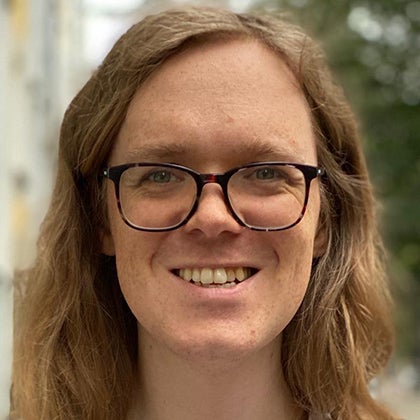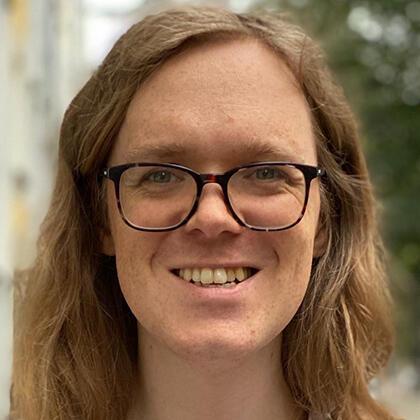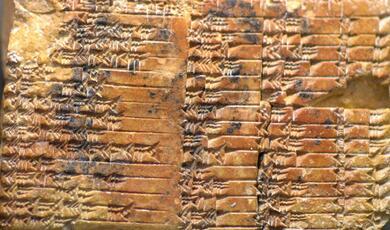How Mathematical Proofs Are Like Recipes
Share
- Details
- Text
- Audio
- Downloads
- Extra Reading
Joint lectures with the British Society for the History of Mathematics.
This talk considers mathematical proofs through an analogy to cooking recipes: that proofs give recipes for mathematical actions to be carried out by the reader. We will see linguistic evidence that written proofs often include explicit instructions in the imperative mood, just like recipes. This will lead to philosophical insights about mathematical diagrams, reading and writing proofs, and why maths is like the Great British Bake Off.
This event will focus upon mathematical proofs. The main speaker, Professor Agathe Keller (6pm) will look at decolonisation of the history of proofs, providing examples outside of what has been called a “colonial library”, using, in particular, Sanskrit sources. This will be preceded by shorter presentations by Dr Richard Oosterhoff (4pm) on "The Invention of Mathematical Proof in the Renaissance", and Dr Fenner Tanswell (4.45pm) on "How Mathematical Proofs Are Like Recipes".
Download Text
How Mathematical Proofs Are Like Recipes
Dr Fenner Stanley Tanswell
19th October 2022
Abstract
This talk proposes that the best way to understand mathematical proofs is through an analogy to cooking recipes: proofs give recipes for mathematical actions to be carried out by the reader. It shows linguistic evidence that written proofs often include explicit instructions in the imperative tense, just like recipes. Pictures can provide instructions in proofs too, demystifying an otherwise thorny philosophical problem. What are the lessons this has for how we read, write, teach, and learn mathematics?
Introduction
What is a mathematical proof? Proofs are central to pure mathematics, containing the techniques, ideas, concepts, insights, connections, interdependencies, and cunning that make up modern mathematical practice. In this talk, I’m going to explain how they are also just like food recipes for your favourite desserts (i.e. rhubarb crumble).
Like physicists have the Standard Model, mathematicians and philosophers of mathematics have over the last century or so settled on a Standard Model of proof that looks something like this:
A proof is a deductive argument: a logically structured sequence of assertions, beginning from accepted premises or axioms, and proceeding by established inference rules to a conclusion, which is the theorem being proved.
This standard model of proof has been extremely successful in a number of ways, such as by making metamathematics possible leading to results like Gödel’s incompleteness theorems, and in the computerisation of mathematics (both in proof checked by computers and proofs created by computers).
However, this model does not faithfully capture all features of actual proofs in practice in modern mathematics. It excludes picture proofs, and other modes of proving. It suppresses the role of the mathematician doing the proving, and the intended audience the proof is directed at. By emphasising proofs as “sequences of assertions” it also rules out other types of language that can be used in proofs.
The Recipe Model of Proofs
In today’s talk I will present an alternative model that I think better captures some of the interesting features of real proofs, something we will call the recipe model of proofs. The idea is that we think of proofs in mathematics through an analogy to cooking recipes.
First of all, both recipes and proofs are used to give instructions. In the recipe case this is instructions for how to make something tasty (if you do it right). In the proof case they are instructions for carrying out some piece of mathematical reasoning, gaining mathematical knowledge (if you do it right). This is reflected in the kind of language that can be used in proofs, and is something I’ll talk about shortly.
Secondly, the analogy emphasises the activity of doing mathematics. A written proof is like a recipe in that both are primarily interesting because of the actions associated with them. You could sit down and read through a cookbook page-by-page, like a massive weirdo, but the main way of using a recipe book is to find something you want to make, and then follow the instructions to actually make it. Then you have something tasty to eat. Likewise, proofs by themselves can be a written record of how to prove some theorem, but the interesting thing is to actually do the reasoning. (This emphasis on activity in mathematics is a major part of the practical turn in philosophy of mathematics, and I’m building especially on the work of Brendan Larvor and Jody Azzouni.)
Thirdly, the analogy is a good one because it emphasises the mathematicians involved in the mathematics. A recipe has an author (maybe several) and a reader, as do proofs. The mathematician as an author want to communicate how to prove a theorem. The reader then wants to go through the reasoning too, and understand how the theorem follows. Thinking in these terms directs us to think about the ways in which the communication functions: How do I best write a proof? How do different audiences read proofs? What is the best way to teach these skills to real people?
Fourthly, there are many styles and formats to present recipes. Think of the difference between Nigella and Jamie Oliver; between Gordon Ramsay or Mary Berry; between an Ottolenghi cookbook and a handed-down recipe from your great grandparents; or a written recipe versus one presented on youtube. Likewise, proofs can be written in journal articles, in text books, presented at blackboards, or scribbled on napkins. Different mathematicians can have different styles in different media.
Having laid out the big idea, let us have a look at some of the details.
The Language of Proofs
First of all, let us think about the language used in recipes and in proofs.
Here’s a part of a recipe for a “Sunshine cake”:
- Separate the eggs.
- Beat the yolks with a rotary beater until they are thick and lemon-colored.
- Beat the egg whites until they are foamy, add the cream of tartar, and continue beating until they are dry.
- Fold the sugar into the egg whites and then fold the yolks into this mixture.
- Sift the flour several times and add it.
- Add the lemon juice and vanilla, pour into a sponge-cake pan, and bake.
Looking at the language used to present this recipe, I think it is fairly typical. A recipe presents a list of instructions. Each of the sentences uses the imperative mood, meaning it tells you to do something. Separate! Beat! Beat! Add! Continue! Fold! Fold! Sift! Add! Add! Pour! Bake!
Compare this to this textbook proof by John Hunter of the Bolzano-Weierstrass theorem.
I think if you were to present this to a mathematician, they would say that this is a typical textbook proof. In the exact same way as the recipe, it is full of imperatives. Suppose! Let! Define! Divide! Choose! Choose! Divide! Choose!
Recall that the standard model of proofs that we started with talks about recipes as sequences of assertions. If this is to count as a proof at all, that model has it wrong.
Is that a deep problem in the standard model, or just a superficial problem in accounting for an isolated example?
A Corpus Linguistics Study
To answer that question, my colleague Matthew Inglis of Loughborough University, and I set about to do an empirical study of language use in modern proofs using methods from corpus linguistics.
“Corpus linguistics” refers to using a large body of texts to study language usage patterns. In this case, we used a body of mathematics texts put together by colleagues Mejia-Ramos et al. (2019). The texts were professional mathematics articles taken from the ArXiv, which is a pre-print server widely used in the English-speaking mathematics community. It is standard practice for mathematicians to make their papers and results available online prior to peer-review and publication, and the system is set up to inform other mathematicians in their area of new work coming out.
Some caveats to this corpus. By using texts from here, we are looking at the work of contemporary mathematicians writing in English. They are primarily professional mathematicians working in university maths departments in the USA, Australasia, or Europe. They are writing for other mathematicians, rather than for students for example. So our study tells us about a certain kind of mathematical writing by a particular community of mathematicians.
The specific papers we used were all of the mathematics papers from the first three months of 2009. They were processed to make it possible to use linguistics software to analyse them, the details of which I won’t go into here. Importantly, this let us separate out the written text within proofs from all of the other mathematical texts surrounding it, allowing a comparison between the language of proofs specifically and the language of mathematics more generally.
We were interested in finding out about the way that instructions are used in written proofs. We did this in several different ways.
The first was to simply look at the frequency with which different verbs were used to form imperatives. There was a pretty cunning way of doing this. Because imperatives in English usually start with the verb, we could look at the texts in a case-sensitive way, searching specifically for when the verbs were capitalised.
The findings were that there are a “core set” of verbs used to give instructions most often in the articles. Most common by far is “Let […]”, but many more showed up a lot. Contrasting the Proofs with general mathematical language showed that the instructional language is far more pronounced within proofs than outside of it.
One worry might be that these frequencies come from a small minority of papers who are using loads and loads of imperatives, rather than it being common across mathematical writing.
To find out about that, we looked at the “span” of the imperatives: what percentage of proofs did they appear in?
On the left-hand side, you can see the percentage of files that the various capitalised verbs appeared in. From “Let” which was in most of the proofs, to “Observe”, which was in around 14%. In isolation, those percentages don’t mean very much, so we have put them next to words that showed up in a roughly similar percentage of papers on the right-hand side. So “Let” appears about as often as “then”, “Note” as “function”, “Suppose” as “thus” and so on. What you can see is that these imperatives appear in a roughly similar number of papers as common mathematical terms. This tells us that the imperative language is used broadly across mathematics papers.
Finally, while we found a core set of verbs used to give instructions in proofs, we want to know if it is just those, or whether it was possible to use other verbs as well. So we manually looked for examples of many other verbs, and found them.
For all of the verbs in the word cloud, there were examples of them being used as imperatives in the corpus of mathematical proofs. For instance:
Set the total degree equal to the sum of the bi-degrees.
Form the commutative cube in which the front and back faces are pullbacks, so that […]
Sum the estimates in the previous corollary.
Estimate the difference on the right-hand side of […] by the triangle inequality to find […]
In summary, the corpus study found that proofs are written with instructions quite often, find a core set of verbs most common and broad across maths papers, but also a flexibility to use other verbs to give instructions when the need arises. In terms of the language use, proofs can very much be like recipes.
Picture Proofs
Let us move on to another place where the recipe model of proofs gives different predictions to standard model. This is about the use of pictures in proofs, or as proofs by themselves. Consider for example, the following proof that the sum of the first n odd numbers is n squared.
This proof is credited by Roger B. Nelsen in his first volume of Proofs Without Words to Nichomachus of Gerasa around 100CE.
The standard model does not fit well with relying on pictures for two reasons:
- Pictures aren’t sequences of assertions, so are not proofs. If we try to extract assertions from the picture, it is underdetermined what they should be and what their logical sequence is.
- A picture can only show a single case, rather than proving a general theorem.
Applied to the previous proof. It isn’t clear what sequence of assertions the proof is expressing, and it could be argued that it is only actually showing the case for n=8.
I don’t find these concerns very convincing, and I think the recipe model helps us to understand why not.
First of all, the recipe model doesn’t need us to figure out which assertions are being conveyed by a diagrams. In fact, pictures can give instructions directly in ways that we are familiar with from everyday life.
For example, you can give a set of LEGO instructions to a child and they will be able to follow what they should do: use the following pieces, combine these ones in these ways and then attach them here. The pragmatics of using arrows, boxes, layout and colour to communicate will function in many different ways, but they can certainly be clear in what the reader should do.
Likewise, anyone who has built IKEA furniture will recognise the style of their instructions. (This may be controversial because people complain about them, but I think their clarity and simplicity is absolutely brilliant.) Here we see which things to use, and which tools NOT to use. We see that two people should work together, and repeat certain actions in certain places.
With this understanding, I think picture proofs can take advantage of many other pragmatic features of pictorial communication. The proof we saw already is an induction proof, and the recipe is showing both the base case directly, and the inductive step for the first seven. Implicitly, it communicates the recipe for how to get the general inductive step: one has a square of side length n, and adds the next odd number as an extra layer to get a square of side length n+1. The general instruction is clear, without the need to convert it into a sequence of assertions.
Similarly, proofs can use arrows and layout to communicate key ideas, as in this proof of Pythagoras’s theorem, which Roger B. Nelsen credits to Frank Burk.
Like the IKEA and LEGO instructions, this uses visual means to communicate instructions. It may be that the mathematics case requires some mathematical training to understand the instructions given to us, but I argue that these are not as mysterious as the standard view would make out.
Lessons for Learning
We have seen that the recipe model of proofs provides quite a different perspective than the standard view of proofs as logical sequences of assertions. Let me finish on some lessons this gives for the learning of proofs. (This draws on some joint work with Keith Weber of Rutgers University in the USA).
One common model of proof teaching for mathematics undergraduates is often called the “apprenticeship model”, where undergrads are being apprenticed to the methods of mathematics. Without going into the strengths and weaknesses of this idea, one thing is obvious. If we want something like this to work, our conception of what mathematicians are doing has to be accurate. If mathematicians are writing with instructions, but say that they aren’t, this presents a very confusing situation for someone to try to learn that situation.
If we conceptualise proofs as “sequences of assertions”, then we will miss out on an important aspect of proving that need to be taught. For example, what is the difference between: Let, Suppose, Assume, Consider, Fix, Take, etc.? This seems like something that can easily be taught as part of proof writing, rather than hoping students will figure it out by osmosis.
Another lesson is that the way that one reads and evaluates a recipe is different to how one evaluates a sequence of assertions:
Assertions: Is this true? Does each step follow from the previous ones?
Recipe: What action am I being asked to carry out? Can I carry out this step? Do I know how? Does it produce the right outcome? Does it guarantee the right properties?
We believe that proof pedagogy should explicitly teach students how to use these instructions appropriately and correctly, rather than presenting a model that assumes they do not exist.
In a slogan: if you want students to learn the how proofs work, maybe you should teach them how actual proofs work.
© Dr Tanswell 2022
References and Further Reading
Azzouni, J. (2004) “The Derivation-Indicator View of Mathematical Practice”, Philosophia Mathematica (III) 12, pp. 81-105.
Hunter, J. K. (2014). An introduction to real analysis. UC Davis: California.
Larvor, B. (2012) “How to Think About Informal Proofs”, Synthese 187, pp. 715–730.
Mejía-Ramos, J. P.; Alcock, L.; Lew, K.; Rago, P.; Sangwin, C.; & Inglis, M. (2019) “Using corpus linguistics to investigate mathematical explanation”, in Fischer, E., & Curtis, M. (eds.) Methodological advances in experimental philosophy, London: Bloomsbury, pp. 239-264.
Nelsen, R. B. (1993) Proofs Without Words: Exercises in Visual Thinking, Washington, DC, The Mathematical Association of America.
Nelsen, R. B. (2000) Proofs Without Words II: More Exercises in Visual Thinking, Washington, DC, The Mathematical Association of America.
Sangwin, C., & Tanswell, F. (forthcoming) “Developing new picture proofs that the sums of the first odd integers are squares”, Mathematical Gazette.
Tanswell, F. & Inglis, M. (in press). The language of proofs: A philosophical corpus linguistic study of instructions and imperatives in mathematical proofs. In B. Srirariman (Ed.) Handbook of the history and philosophy of mathematical practice. Springer.
Tanswell, F. (forthcoming) "Go Forth and Multiply: On Actions, Instructions and Imperatives in Mathematical Proofs”. In Bueno, O. & Brown, J. (eds.) Essays on the Work of Jody Azzouni.
Tanswell, F. S. (2017) “Playing with LEGO and Proving Theorems”, in Cook, R. T. & Bacharach, S. (eds.) LEGO and Philosophy: Constructing Reality Brick by Brick, Oxford: Wiley Blackwell, pp. 217-226.
Weber, K., & Tanswell, F. (2022) “Instructions and recipes in mathematical proofs”. Educational Studies in Mathematics 111, pp. 73–87.
References and Further Reading
Azzouni, J. (2004) “The Derivation-Indicator View of Mathematical Practice”, Philosophia Mathematica (III) 12, pp. 81-105.
Hunter, J. K. (2014). An introduction to real analysis. UC Davis: California.
Larvor, B. (2012) “How to Think About Informal Proofs”, Synthese 187, pp. 715–730.
Mejía-Ramos, J. P.; Alcock, L.; Lew, K.; Rago, P.; Sangwin, C.; & Inglis, M. (2019) “Using corpus linguistics to investigate mathematical explanation”, in Fischer, E., & Curtis, M. (eds.) Methodological advances in experimental philosophy, London: Bloomsbury, pp. 239-264.
Nelsen, R. B. (1993) Proofs Without Words: Exercises in Visual Thinking, Washington, DC, The Mathematical Association of America.
Nelsen, R. B. (2000) Proofs Without Words II: More Exercises in Visual Thinking, Washington, DC, The Mathematical Association of America.
Sangwin, C., & Tanswell, F. (forthcoming) “Developing new picture proofs that the sums of the first odd integers are squares”, Mathematical Gazette.
Tanswell, F. & Inglis, M. (in press). The language of proofs: A philosophical corpus linguistic study of instructions and imperatives in mathematical proofs. In B. Srirariman (Ed.) Handbook of the history and philosophy of mathematical practice. Springer.
Tanswell, F. (forthcoming) "Go Forth and Multiply: On Actions, Instructions and Imperatives in Mathematical Proofs”. In Bueno, O. & Brown, J. (eds.) Essays on the Work of Jody Azzouni.
Tanswell, F. S. (2017) “Playing with LEGO and Proving Theorems”, in Cook, R. T. & Bacharach, S. (eds.) LEGO and Philosophy: Constructing Reality Brick by Brick, Oxford: Wiley Blackwell, pp. 217-226.
Weber, K., & Tanswell, F. (2022) “Instructions and recipes in mathematical proofs”. Educational Studies in Mathematics 111, pp. 73–87.
This event was on Wed, 19 Oct 2022
Support Gresham
Gresham College has offered an outstanding education to the public free of charge for over 400 years. Today, Gresham College plays an important role in fostering a love of learning and a greater understanding of ourselves and the world around us. Your donation will help to widen our reach and to broaden our audience, allowing more people to benefit from a high-quality education from some of the brightest minds.


 Login
Login







